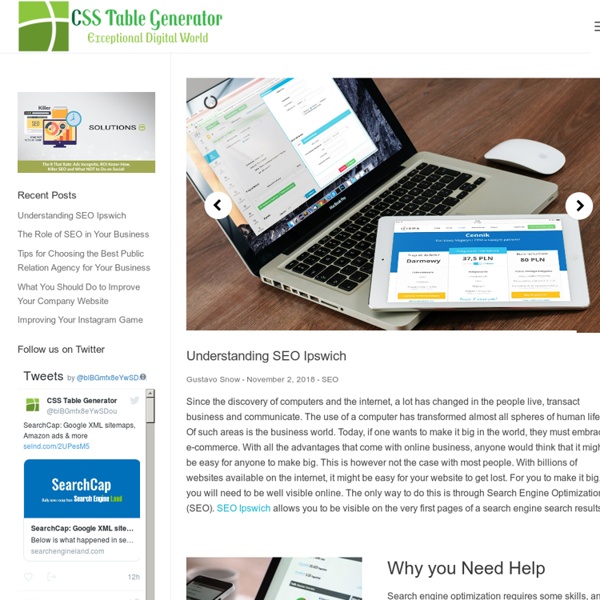



CSS Sprite Generator | Project Fondue Best CSS Button Generator: Create CSS-only Buttons CoffeeScript spin.js HTML & CSS Table Border Style Wizard Compatibility Notes If you are using Internet Explorer 6, you should be able to use this wizard with only minor limitations. This page does not work with Opera 8 or IE 5 on Mac. Internet Explorer 6 does not support the border-spacing CSS2 table property. Table Border Style Wizard Welcome to the totally revamped HTML and CSS border style wizard! The style sheet code generated by this wizard shows the easy way to apply a style to a table. The above example doesn't show it, but you can also efficiently alternate the row colors in an HTML table by using inheritance. The -moz-border-radius style tag will be rendered in browsers based on the Gecko Runtime Engine. HTML Toggle Buttons You might also have noticed the interesting toggle buttons that control the table style. The toggle buttons above behave like real radio buttons, like the ones on old-fashioned car radios. This is a lot of work to do something fairly simple. Get Firefox Now! Links More CSS Wizards Recommended Books
Prefix free: Break free from CSS vendor prefix hell! -prefix-free lets you use only unprefixed CSS properties everywhere. It works behind the scenes, adding the current browser’s prefix to any CSS code, only when it’s needed. The target browser support is IE9+, Opera 10+, Firefox 3.5+, Safari 4+ and Chrome on desktop and Mobile Safari, Android browser, Chrome and Opera Mobile on mobile. If it doesn’t work in any of those, it’s a bug so please report it. Just before you do, please make sure that it’s not because the browser doesn’t support a CSS3 feature at all, even with a prefix. In older browsers like IE8, nothing will break, just properties won’t get prefixed. Test the prefixing that -prefix-free would do for this browser, by writing some CSS below: Properties/values etc that already have a prefix won’t be altered. It’s not ideal, but it’s a solution, until a more intuitive way to deal with these cases is added in -prefix-free. Please note that in unsupported browsers like IE8, no such class will be added. Firefox (and IE?)
Text Rotation with CSS Once again, after reading somebody else's article, I felt inspired to put together an alternative example. In this case: Text Rotation. Within the article I linked to, the example uses an image sprite and a sprinkle of CSS to get things positioned right. Well, maybe not so much a sprinkle. It's like the top fell off the pepper shaker and you've suddenly got a large pile of pepper on your food. It makes me want to sneeze. Thankfully, many of the popular browsers of today support the ability to rotate HTML elements. <div class="example-date"><span class="day">31</span><span class="month">July</span><span class="year">2009</span></div> Nice and clean without too many extras. The Magical CSS For Webkit and Firefox (as of 3.5), you can take advantage of the proposed transform property to handle the rotation. -webkit-transform: rotate(-90deg); -moz-transform: rotate(-90deg); In order to perform a transformation, the element has to be set to display:block. In action
CSS3 PIE: CSS3 decorations for IE liege.mine.nu: Website analytical review | SiteRatios.Com Athena : apprendre autrement.. Rated 1.6 out of 5 stars, based on 7 metrics Updated on Feb 24,2013 at 2:38 PM [1years ago] LIEGE.MINE.NU is rated 2.21 out of 7 SEO metrics which we consider as an Average rating. The site seems to be popular in Japan with a rank of #3,044 and brings in 31% of the site's traffic which is 26.00% of the total pageviews to the site. When analyzed on Feb 24, 2013 the site was hosted in BELGIUM with the IP address 82.212.151.6. While reviewing the site, we have considered the following metrics for positive ratings: Excellent Alexa Global Rank rating (#14,480) Excellent SEOMoz Subdomain Rank (3.14/10) Very Good Google PageSpeed Score (70/100) Very Good Alexa Speed Score (61/100) Very Good number of daily visitors (approx. #88,074) The site has MyWot Reputation ratings The site has MyWot Confidence ratings The site was negatively rated due to the following metrics:
Selectivizr - CSS3 pseudo-class and attribute selectors for IE 6-8 Convertir du Flash (SWF) en HTML5 avec Swiffy Qu'on l'aime ou non, la technologie Flash existe encore et aucune date d'enterrement n'est prévue par Adobe. Utilisé à bon escient, il est toujours possible d'en avoir plein les mirettes avec des animations sexy. Pourtant, une difficulté voit le jour : plusieurs plate-formes ne supportent pas l'installation du plug-in Flash. Alors, pourrait-on rendre ces animations HTML5 friendly ? C'est ce que nous propose Google avec Swiffy ! Cet outil est destiné à convertir le contenu Flash (SWF) en code HTML5, ce qui permet de le faire fonctionner sur des supports qui, à la base, ne supportent pas Flash comme les mobiles et tablettes (Android, iOS...). Test en situation réelle Faisons un essai avec un fichier relativement classique. L'animation boucle Au survol, l'animation réagit Au clic également Il y a différents effets (opacité, flou de mouvement..) Une animation Flash des plus simples, vous en conviendrez Choix de la méthode de conversion L'extension pour le logiciel Flash Résultat du test Demo
Swiffy As part of our transition of display ads to HTML5. the Swiffy Flash conversion tool is no longer available. We will continue to serve the Swiffy runtimes, so any files you have already converted will continue to play. Today more consumers are using the web in HTML5 compatible environments than Flash-compatible environments. In order to reach as large an audience as possible, we encourage everyone to transition to HTML5 authoring. Developers who currently create Flash SWF files have several ways to switch to HTML5 including Adobe Animate and Google Web Designer. If you need to play an existing Flash SWF file in your browser alone, you might be able to use Mozilla’s Shumway.